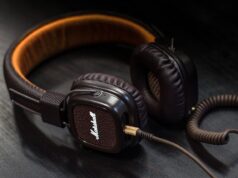
Table of Contents
What is aptX HD?
aptX HD is the next generation of aptX. Because aptX is far more widely used than the HD variant, there’s a strong chance you’ve heard of it. It’s been there since the 1980s, but it’s currently owned by Qualcomm, the company behind the Snapdragon processors that power the majority of Android phones.
aptX can broadcast your music in ‘CD-like’ 16-bit/44.1kHz quality, but it isn’t really “CD-quality” because it is compressed. When sent wirelessly to headphones or a Bluetooth speaker, the compression helps keep latency to a bare minimum.
aptX HD is required if you want improved sound quality via Bluetooth. The new technology, which can accommodate high-definition audio up to 24-bit/48kHz, was introduced in 2016 to provide better streaming quality. Qualcomm claims that its sound quality is “better than CD” and that it can even improve the sound of ordinary resolution audio files.
aptX HD is also meant to increase the signal-to-noise ratio, so you should be able to hear even the tiniest details in your music.
Which devices support aptX HD?
To take advantage of the advantages of aptX HD, make sure your device supports it. The CSR8675 Bluetooth audio system-on-chip (SoC) will be used in these products since it can support 24-bit audio from start to finish.
When aptX HD was originally released, few devices supported it, but as time goes on, more manufacturers are embracing higher-quality streaming. Indeed, according to Qualcomm’s website, there are currently over 280 items available, ranging from smartphones to media players to headphones and amplifiers.
A list of Headphones can be seen below. It’s not comprehensive, but it does include a number of popular Headphones.
Headphones
- 1More Stylish BT Pro
- Audio Technica ATH-DSR9BT
- Audio Technica ATH-DSR5BT
- Bowers & Wilkins PX Wireless
- Beyerdynamic Aventho Wireless
- Beyerdynamic Xelento Wireless
- Bowers & Wilkins PX5 and PX7
- Nuraphone
- Nuraphone Nuraloop
- OnePlus Bullets Wireless 2
- Sony WH-1000MX2
- Sony WH-1000MX3
- V-Moda M200 ANC
- Yamaha YH-E500A
Frequency response
The sample rate (frequency) and bit-depth are the two key elements that influence the file size for audio. If you can remove a portion of high-frequency stuff that is difficult for people to hear anyhow, clever codecs can save a lot of space. However, that hardly qualifies as CD-like quality, so we’ll start here to investigate Qualcomm’s claims.
Both aptX and aptX HD have the same frequency response, which faithfully reproduces nearly the whole audible spectrum. Neither codec can handle 96kHz files, and they’re both limited to 48kHz. This guarantees that no notes in your music will be modified inexplicably by your phone.
The audio is passed through a low pass filter with little ripple and a corner frequency of roughly 18.9kHz by the codec. This is close to the limits of human hearing, therefore the complete spectrum of musical material in the original file is preserved. So far, the claims of generating sound that is indistinguishable from CD quality have proven to be true.
This frequency response is nearly identical to the default SBC Bluetooth codec, which is supported by all devices and extends up to 44.1/48kHz. The only visible change is that the SBC passband has slightly greater ripple at very high frequencies. This ripple could indicate higher high-frequency distortion than aptX, so we’ll have to dive deeper to see what the differences are.
Noise and distortion
Bluetooth codecs maximise bandwidth savings by splitting audio into many frequency bands (aptX utilises four) and minimising the amount of storage space available. To put it another way, codecs like aptX don’t waste time on notes that aren’t heard. Quantization is the term for this method.
If you’re not familiar with the terms noise floor and quantization, they’re essentially the same as talking about bit-depth. The signal level at which the music we want to hear becomes indistinguishable from the background noise electronic system, or in this case codec encoding method, is referred to as noise and bit-depth. The lower the noise floor, the finer the information captured—and thus the higher the quality. A 16-bit signal has a maximum dynamic range of 96dB, 16-bit with dithering has roughly 112dB, and 24-bit has a maximum of 144dB. However, even the greatest hardware will only provide roughly 124dB of capture, which is well than enough for headphone listening volumes.
The noise shapes of aptX and aptX HD are quite similar, according to data collected by Robert TriggsaptX and aptX HD. As you can see, aptX has a range of about 90dB from 20Hz to 5kHz, and aptX HD has a range of about 102dB. The level of noise increases to around -80dB with aptX and -92dB with aptX HD around 4 to 8 kHz. Finally, at frequencies between 8 and 20 kHz, there is still more noise. For aptX, this is around -74dB, while for aptX HD, it’s around -86dB. Even at 15kHz, neither of the two codecs imparts any harmonic distortion to the test tones.
Because to aptX’s variable sub-band bit-rate encoding, the noise floor varies. At higher frequencies, the codec uses fewer bits, resulting in greater noise. The main difference between aptX and aptX HD is that the latter adds two extra bits of information to all of the codec’s frequency bands, resulting in a noise floor improvement of 12dB. This is ideal for high-frequency detail that might otherwise be lost in conventional aptX because to the high noise level.
So, why would you want to do something like this with a variable bit-depth? Your ears, which have varied audible sensitivity at different frequencies, are most sensitive around 1kHz, before losing sensitivity about 4kHz up to 8kHz, and then losing most of your hearing abilities between 10kHz and 20kHz (depending on the age and health of your inner ear). It’s no surprise that the noise floor of aptX corresponds to this pattern. According to science, high frequencies cause your ears to be less sensitive to noise, making it a good place for Bluetooth codecs to save bandwidth.
16 vs 24 bit
The noise floor discussion brings us back to the codec specifications. The -90dB noise floor of aptX is close to that of 16-bit audio, but it falls short of being a technical match for a properly dithered CD track. Although the audible differences will be small at real-world listening intensities, Qualcomm’s promises of “CD-like” quality appear to be accurate.
…it’s clear that the noise floor doesn’t extend low enough to leverage the full capabilities of a 24-bit track, especially in the high frequency bands.
Although aptX HD supports 24-bit audio, it’s evident that the noise floor isn’t low enough to fully exploit the 24-bit track’s possibilities, especially in the high frequency regions. In fact, the -112dB noise floor of dithered 16-bit audio is even higher. The question of whether aptX HD is “indistinguishable from Hi-Res” is a more contentious one, as there isn’t enough time to go over the differences between CD and Hi-Res here. To put it another way, it makes a good effort to cover the constraints of human audio perception. With that in mind, the lower noise profile of aptX HD should also help 16-bit audio files.
A test revealed margin of error variances in the noise floor between a correctly dithered 16 bit and a Hi-Res 24-bit file when played using aptX HD. Both files, however, benefit from the increased noise floor and headroom at high frequencies. Even if your music library consists of 16-bit files, aptX HD is the preferable codec if you have appropriate gear.
Is either better than Bluetooth’s default SBC?
The frequency range of SBC is quite similar to that of aptX, with a roll-off shortly before 19kHz. The noise floor and high frequency distortion are the most significant differences. At lower frequencies, SBC is equivalent to aptX, however it performs significantly worse than aptX HD. SBC, on the other hand, starts creeping up its noise level a little earlier at 2.5kHz, compared to Qualcomm’s codecs at 5kHz. The noise floor for music below 2.5kHz is -92dB, which is comparable to aptX but not nearly as good as the -102dB of aptX HD. Between 2.5-5kHz and 8-11kHz, SBC’s noise floor rises to -85dB, falls to -90dB between 5-8kHz, and reaches highs of -80dB above 14kHz.
However, the test reveals a number of extra high-frequency peaks. This doesn’t appear to be general noise, given how isolated they are. Harmonic and intermodulation distortion, on the other hand, is something we want to avoid in high-quality audio systems and codecs. The aptX codecs do not have the same problem.
SBC exhibits mixed signal distortion, aptX does not.
I also did a typical intermodulation distortion test and a 1kHz square wave test across both codecs to see whether this was the case. The IMD results show that SBC has issues with mixed frequency material, resulting in a number of noticeable spikes of distortion, but aptX does not. Similar anomalies were not seen in the 1kHz square wave test, indicating that SBC has a problem with mixed high and low frequency content.
It’s crucial to realise that SBC is available in a number of configurations and quality levels. While our top-of-the-line smartphones all performed admirably, devices with older or lower-cost Bluetooth components may employ higher compression settings, resulting in increased distortion and poor noise performance.
One of SBC’s biggest flaws as a music audio codec is ambiguity. aptX’s main strength, other from better quality, is its steady performance.
Implications for aptX Adaptive
In addition to aptX and aptX HD, Qualcomm’s newer aptX Adaptive codec will be supported by forthcoming devices. We can’t test that just yet, but based on these findings and what we know about aptX Adaptive, we can extrapolate some consequences.
Essentially, depending on the radio frequency environment and content being played, the Adaptive codec will scale in quality between aptX Classic and HD. Because of the sub-band bit-depth variances, the only difference between Classic and HD is the noise floor profile. As a result, when aptX Adaptive adjusts its quality settings on the fly, it will scale between these noise floors.
Overall, Qualcomm’s aptX line-up appears to have a decent Bluetooth audio codec. Although the claims of CD-like quality hold up under investigation, real Hi-Res over Bluetooth is still a long way off. Meanwhile, the most significant advantage of switching to aptX HD is its high frequency quality, which preserves those delicate shimmers and harmonics that dedicated music fans despise missing out on.

![What are IP Ratings For Headphones? What are IP Ratings: Headphones [Information Article]](https://proheadphones.net/wp-content/uploads/2020/12/What-are-IP-Ratings-Headphones-Information-Article--238x178.jpg)




